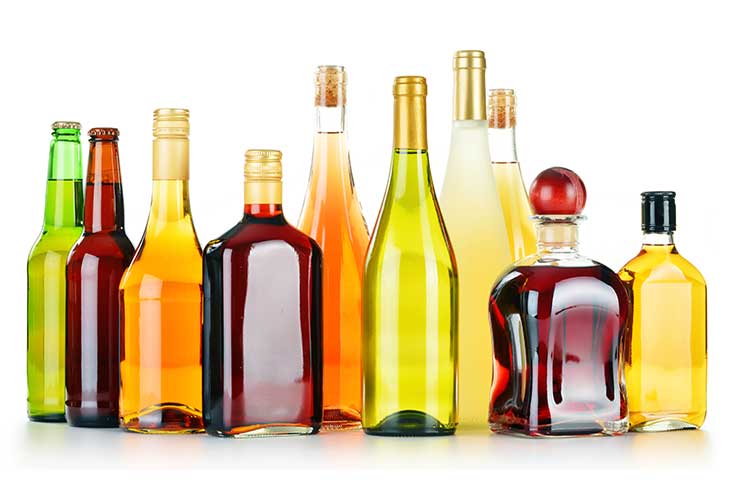Alcohol is a source of empty calories, so called because of the absence of micronutrients (essential amino acids, fibres, vitamins and minerals).
Due to its large amount of kcal and its poor nutritional quality, alcohol consumption is not really advised to anyone, let alone those who are on a low-calorie diet or are looking to maintain their desired weight. If that is the case, then what can we drink that is non-alcoholic when meeting up with friends, or family, or going to events and parties…? In this article, we will help you choose an alternative drink.
Tania Mesa – Director of the Neolife Nutrition and Nursing Unit
Estefanía Schoendorff – Neolife Nutrition and Nursing Unit
Not only does alcohol present a huge amount of calories but, according to the World Health Organization, it is also linked to more than 30 diseases.
In today’s society, drinking alcohol is tolerated, encouraged and defended. However, the harmful effects of alcohol have been known since ancient times: excessive drinking is dangerous and can lead to many diseases, along with alcoholism, which is a chronic, progressive and fatal disease characterized by the build up of alcohol tolerance, physical dependence and pathological changes to the body’s organs.
Unlike coffee and tobacco, alcohol changes the personality of those who consume it in excess and it significantly affects their self-awareness.
In the International Classification of Diseases by WHO (1) the term alcohol is referred to as the cause or aggravating factor in more than 30 diseases, some of the most common being: mental disorders, neurocognitive changes, changes affecting the digestive system, esophageal hemorrhages, cirrhosis of the liver and cancer…
However, in this article we are not here to talk about diseases caused by alcohol, but rather its nutritional characteristics, the absence of nutritional properties and how to choose the best alternative drink options at social, festive or work events.

When we ingest alcohol (2), 20% of this is absorbed in the stomach and the remaining 80% in the small intestine. The rate of absorption will depend on the amount ingested, the type and percentage of alcohol, if you have eaten, and of course, on the physiology of each person, including sex and age as determining factors.
Within 30 to 90 minutes after ingesting alcohol, it will have already been completely absorbed by the body, and will be in the process of being distributed though the bloodstream throughout the body.
Most of the alcohol is metabolized or destroyed in the liverby the dehydrogenase enzyme. The remaining alcohol, not metabolized by the liver, is eliminated through urine and a small part by sweating and exhaling (note the characteristic unpleasant ethanol smell on the breath of a drunk person). Therefore, with regards to the body, we can say that alcohol is dangerous and, when taken in abusive quantities, damages our body, makes us sick and accelerates the aging process.
When talking about alcohol in terms of nutrition, we tend to refer to ethyl alcohol (or ethanol). Alcoholic beverages contain a variable % of alcohol, which usually ranges between 2 and 4 abv (alcohol by volume) in lagers and sparkling wines, up to more than 50 abv in stronger high-alcohol content drinks.
The ethyl alcohol content present in various alcoholic beverages can be calculated following the formula: “grams of alcohol = (alcohol content in ml x 0.97) / 100”, since one abv corresponds to 1 ml of alcohol per 100 ml of beverage (1 ml of alcohol being equal to 0.9 g).
Alcohol lacks nutrients: it is a source of empty calories, so called because of the absence of micronutrients (essential amino acids, fibres, vitamins and minerals). This is why alcohol does not nourish but rather fattens us up: representing 7 kcal per gram of pure alcohol. Therefore, at a nutritional level, the greater the abv of alcohol contained in the alcoholic beverage we are going to drink, the greater amount of empty calories we take on and the more difficult it will be to get rid of them. For example, 100 ml of Scotch whisky – around 40 abv – presents about 244 kcal, while 100 ml of cider – between 2 to 8 abv – would give us 42 kcal.
Due to its large amount of kcal and its poor nutritional quality, alcohol consumption is not really advised to anyone, let alone those who are on a low-calorie diet or are looking to maintain their desired weight.
If that is the case, then what can we drink that is non-alcoholic when meeting up with friends, or family, or going to events and parties…?
When socializing, we can find drinks that can be consumed daily, such as water, and other non-alcoholic drinks that can be consumed without misuse, and where the calorie content is mainly dependent on its sugar content.
For drinks consumed daily, we recommend:
- Water: the only thing that will actually quench our thirst, in addition to providing zero calories. Ideally, we ought to drink roughly between 1.5 to 2 liters of water per person per day.
- Sparkling water: this can be the alternative for those who want to drink something refreshing and fizzy when in a social setting.
- Fruit and vegetable juices or shakes(orsmoothies): 100% natural and non-processed, these help us to maintain weight and provide us with essential vitamins for our health. However, it is still much healthier to include whole fruit and vegetables in our diet, as these provide us with more fibre and help quench our thirst more quickly.
- Skimmed milk with pure cacao (0% added sugar ) sweetened with stevia: recommended in winter; with a low calorie content, this is a good alternative for those who dislike coffee.
- Infusions or teas: cold in summer and hot in winter, unsweetened or sweetened with Stevia. The most popular are green, red, black, and white tea.
- Coffee: a great companion for almost any time of the day, you can drink it on its own, add extra water for an Americano, or add a dash of milk and sweeten with Stevia. Avoid all types of coffee prepared with cream, caramel, sugar or sweeteners that add lots of kcal.
For occasional or moderate intake:
- Bitter Kas: a low calorie carbonated soft drink similar to sparkling water but with added flavor, for social events at any time of the day or night.
- Tonic: 34 kcal per 100 ml, an interesting alternative for those wanting a soft drink.
- Alcohol-free beer: 37 kcal per 100 ml.
- Nestea, sugar free: with only 1 kcal per serving, this could be a good alternative in social situations.
- Coca-Cola Zero or Light: provides 0-1 kcal per 100 ml.
- Kas Lemon or Orange: 33-34 kcal per 100 ml.
- Fanta Orange or Lemon: 38-46 kcal per 100 ml.
- Lemonade: 100 ml presents around 42 kcal and is almost 20% protein.
- Soda water (also known as Syphon): one glass presents around 35 kcal. Fat free, but limit your intake due to its 8.8 g of sugar in the form of carbohydrates.
- Alcohol-free grape must: 61 kcal per 100 ml, the ideal drink over ice in summer.
- Eggnog: 88 kcal per 100 ml, a good choice for the Christmas holidays.
- Gatorade (similar to Aquarius): 23 kcal per 100 ml.
- Blended fruit smoothie: drink only occasionally as it can represent around 261 kcal per 100 ml. It is better to eat portions of fruit instead and without mixing, if on a low calorie based diet.
For the occasional alcoholic drink:
- Cider: represents about 40 kcal per 100 ml, well suited to a Christmas party.
- Alcoholic beer: contains about 45 kcal per 100 ml. It would be better to choose 0% (alcohol free), as this can be suitable even when dieting to lose weight.
- Cava: a sparkling wine with around 60 kcal per 100 ml, ideal for social events at work or celebrations such as birthdays or anniversaries.
- With regards to wines(3), although we can make a distinction in terms of age, sweetness, and flavor… here we will use the more traditional classification:
- Still wines: with alcohol content ranging between 8.5 and 14.5 abv. These wines are advised when dieting or controlling your weight.
- Red wine: contains 75 kcal per 100 ml. A glass of red wine a day is recommended for its high content of antioxidants and nutrients which are beneficial to our health.
- White wine: contains 82 kcal per 100 ml. As such, it is slightly higher in calories than red wine.
- Rosé: one glass contains around 71 kcal.
- Fortified wines: these are dry wines produced by select grapes and with an alcohol content ranging from 14 to 23 abv. Because of their high alcohol content, these represent a greater quantity of kcal (up to 150 kcal per 100 ml).
- Natural sweet wines, mistelas and sparkling wines: these are characterized by a sugar content of around 5 g per liter. Due to their high sugar content, you should try to avoid drinking these.
- Still wines: with alcohol content ranging between 8.5 and 14.5 abv. These wines are advised when dieting or controlling your weight.
- With regards to distilled beverages, below are some of the kcal per serving:
- Patxaran: 83 kcal per shot (25 ml approx.).
- Anisette: 117 kcal per serving (44 ml approx.)
- Cognac: 103 kcal per serving.
- Bourbon: 103 kcal per serving.
- Whisky: 250 kcal per 100 ml
- Rum: 231 kcal per 100 ml
- Honey Rum: 440 kcal per 100 ml
- Gin: 263 kcal per 100 ml
- Tequila: 110 kcal per 100 ml
Spirits and liquors are very high in calories. In addition, if they are mixed with a sugary drink, we must then also take into account the additional calories of the mixer. Therefore, if we mix a serving of rum with Coca-Cola, Lemonade or Redbull, we can be taking in up to around 400 kcal per 100 ml.
Therefore, if you are on a low-calorie diet during the week, but when the weekend comes around you have on average 4 or 5 alcoholic drinks in a single night or during a single event, you will have ruined all of the work and effort you put in during the week, taking in way more calories than your body needs, and what is worse, without any nutritional value.
At Neolife, our aim is to teach you how to progressively reduce your alcohol intake on special occasions,whether social, with family or through work… We help you to achieve a healthy weight and then maintain it through a comprehensive and personalized treatment, with a specialized nutritional team.
BIBLIOGRAPHY
(1) https://www.ncbi.nlm.nih.gov/pmc/articles/PMC3307043/table/t1-arh-34-2-135/
(2) https://www.tabladecalorias.net/
(3) https://fundamentosdeenologia.wordpress.com/2013/02/20/el-vino-y-su-clasificacion
